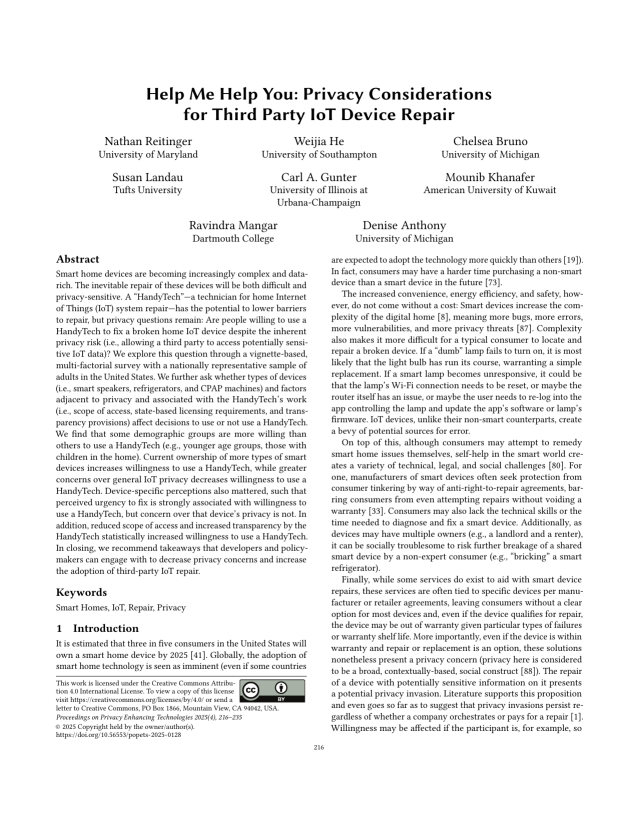Help Me Help You: Privacy Considerations for Third Party IoT Device Repair
Authors: Nathan Reitinger (University of Maryland), Weijia He (University of Southampton), Chelsea Bruno (University of Michigan), Susan Landau (Tufts University), Carl A. Gunter (University of Illinois at Urbana-Champaign), Mounib Khanafer (American University of Kuwait), Ravindra Mangar (Dartmouth College), Denise Anthony (University of Michigan)
Volume: 2025
Issue: 4
Pages: 216–235
DOI: https://doi.org/10.56553/popets-2025-0128
Abstract: Smart home devices are becoming increasingly complex and data-rich. The inevitable repair of these devices will be both difficult and privacy-sensitive. A "HandyTech"—a technician for home Internet of Things (IoT) system repair—has the potential to lower barriers to repair, but privacy questions remain: Are people willing to use a HandyTech to fix a broken home IoT device despite the inherent privacy risk (i.e., allowing a third party to access potentially sensitive IoT data)? We explore this question through a vignette-based, multi-factorial survey with a nationally representative sample of adults in the United States. We further ask whether types of devices (i.e., smart speakers, refrigerators, and CPAP machines) and factors adjacent to privacy and associated with the HandyTech's work (i.e., scope of access, state-based licensing requirements, and transparency provisions) affect decisions to use or not use a HandyTech. We find that some demographic groups are more willing than others to use a HandyTech (e.g., younger age groups, those with children in the home). Current ownership of more types of smart devices increases willingness to use a HandyTech, while greater concerns over general IoT privacy decreases willingness to use a HandyTech. Device-specific perceptions also mattered, such that perceived urgency to fix is strongly associated with willingness to use a HandyTech, but concern over that device's privacy is not. In addition, reduced scope of access and increased transparency by the HandyTech statistically increased willingness to use a HandyTech. In closing, we recommend takeaways that developers and policymakers can engage with to decrease privacy concerns and increase the adoption of third-party IoT repair.
Keywords: smart homes, IoT, repair, privacy
Copyright in PoPETs articles are held by their authors. This article is published under a Creative Commons Attribution 4.0 license.

